|
MORE ABOUT PT GERMEIN
|
CAN YOU HEAR THEM?
Can you hear the flood tide making
over wet and wrinkled sand;
rippling tinkling round the jetty piles,
dark and sombre where they stand?
Stark and eerie in the moonlight,
casting shadows from the past,
ghostly shadows in the still night,
like sail and spar and mast.
Can you hear the sea breeze moving,
whispering tiny waves that rise,
bringing movement in the dim light,
bearing mournful sea bird cries?
Can you hear the breeze increasing,
holding high the urgent waves,
bearing long lost sailors' spirits
from their far flung ocean graves?
Can you hear the sea wind howling,
screaming loud to desperate sea,
rushing madly tumbling shorewards,
and the white spume blowing free?
Can you hear the sea wind roaring,
mighty rollers breaking strong,
fetch those endless spirits swiftly
from the hulks where they belong?
Mighty graceful "Kobenhavn,"
great barque "Karpfanger" too,
rest eternal in the Cape's embrace,
and with them lie their crew.
From Germany and Denmark,
near one hundred laughing boys.
They sailed to learn the sailor's trade,
to taste the wanderer's joys.
Many loving hearts were broken,
many Mothers' tears flowed free
when "Lutine's" dread bell tolled
those ships, taken by the sea.
Can you hear the great gales screaming,
speed those souls ashore again?
Do you see them in the shadows,
sometimes in Port Germein?
NOEL SMITH
Noel Smith (shown below, centre) was a 13 year old ship's cabin boy when he first visited Port Germein in 1940.

YORK 1860
She lies forlorn in the island mud
Shedding rust red tears of iron blood
From her stark bare ribs and shattered skin,
From her vacant holds and the frames therein.
The rising tide conceals her grief,
Hides her shame and brings relief
From the winds that mock and the blazing sun,
An unwanted wreck now her work is done.
Proud once she clove the timeless sea,
Rolled and plunged where the winds blow free,
Defied and beat the angry gales
And sang to the power of her straining sails.
Where lie the bones of those she bore?
Turned to dust and seen no more
Bared and bleached in a coastal cave
Or coral clad in an ocean grave?
The tide recedes and her bones emerge
From rippling waves and ocean surge.
The whirling eddies sob and sigh
A mournful dirge for days gone by.
To rest the raucus birds arrive,
Her sad remains become alive.
The calls and cries of the noisy throng
Replace the sailors' shanty song,
Which rang to the beat of stamping feet
As they trimmmed a sail and hauled a sheet,
Or sang of the love of those at home
And dreamed of a time they would cease to roam.
Sometimes in the black of a moonless night
The guiding stars and beacon's light
Fetch her crews again for Eternity
Released from the grip of the hungry sea.
The sou'west breeze begins to move,
To caress her bones and softly soothe.
Through blank and empty rivet holes
Come the whispering calls of sailors' souls.
They cry and they sing as the breeze grows strong,
They sing of the sea where they all belong,
Where they drift and they soar with the albatross,
Of the fearful wrecks and the awful loss.
Of the bright young lives and sailors old,
Of the hurt and suf'ring never told,
Of the screaming child who died alone
When the grasping ocean claimed her own.
With the wind's increase those lost souls shriek,
Call for rest, and the peace they seek
For a saviour's promise not fulfilled
That their wailing pleas are heard and stilled.
With the morning sun the tide makes high,
The wreck submerged and the spirits fly
To the dim dark depths or the rocky shore
Which claimed their bones long years before.
They'll come again when the breeze is right,
Drifting ghostly silent through the night.
Then the wind gives voice to those restless souls,
Screaming through the rivet holes.
Poor lonely 'York' in the island mud
With your rust red streaks of iron blood
Few mortals now recall your name,
As the earth reclaims your iron frame.
NOEL SMITH
5-5-1993
The 'York' was an iron vessel built about 1860 in Scotland. She finished her working life as a coal hulk and lighter in Port Pirie in about 1922. She was beached on the southern side of Weeroona Island where she was used as a wharf or loading platform for barges carting stone to Port Pirie.
A dear and very old lady lived in a shack very close to the 'York' remains. She told me of listening to the voices of
the 'York' and that the spirits of her crews often visited her on stormy nights. She learned this poem and could often
be heard standing on her little verandah reciting it to the spirits of the 'York'.
NOEL SMITH

THE GRAND OLD LADY
You stand there in your glory, a landmark in the sky,
You hold so many memories of a hundred years gone by.
You know that we respect you for all that you've been through
The grand old lady of our town, we lift our hats to you.
You've seen so many changes that make our world today
From the days when granpa brought his wheat down by bullock dray.
Through the winding Flinders Ranges across the Baroota Plain
He transported his produce to the ships at Port Germein.
Here we have the longest jetty, built in eighteen eighty one,
It's where the ships from across the world one time used to come
To get their loads of cargo, and sail across the seas,
If you could tell us stories, what wonderful memories.
Part of a song written by NORMA BAKER, Port Germein.

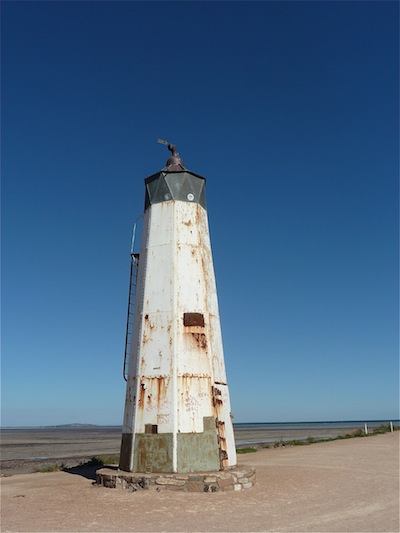

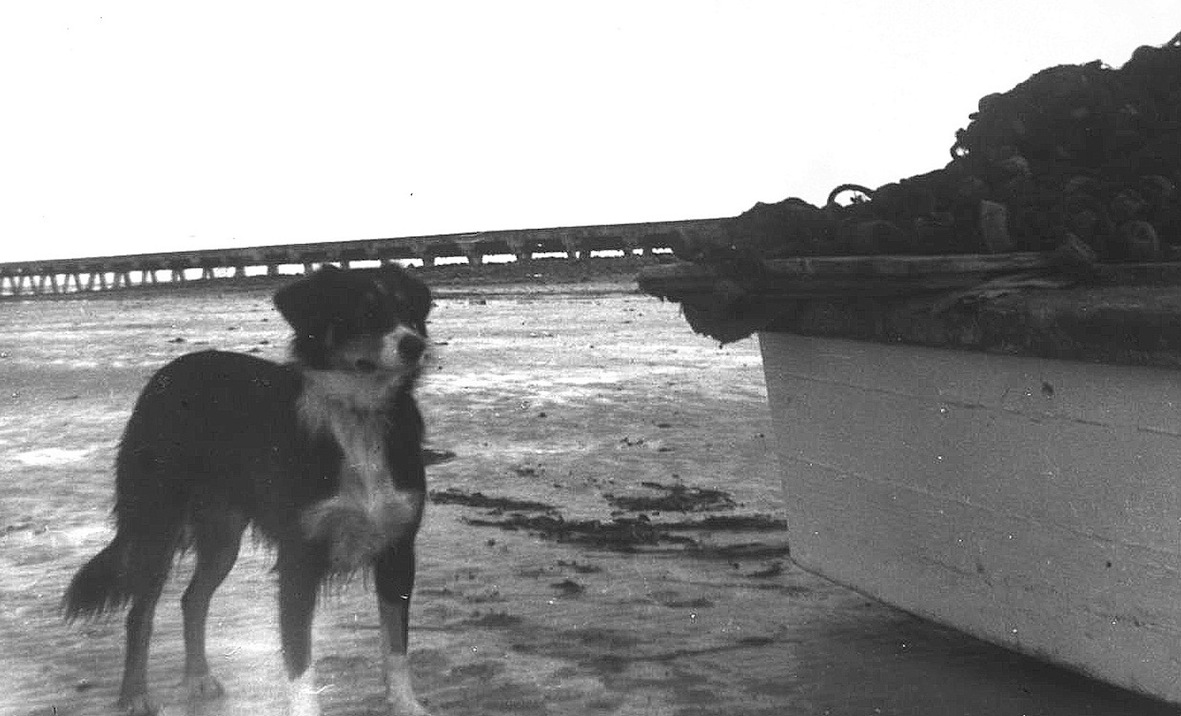
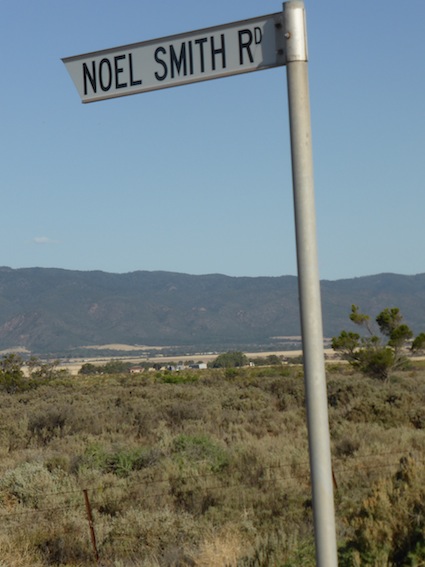
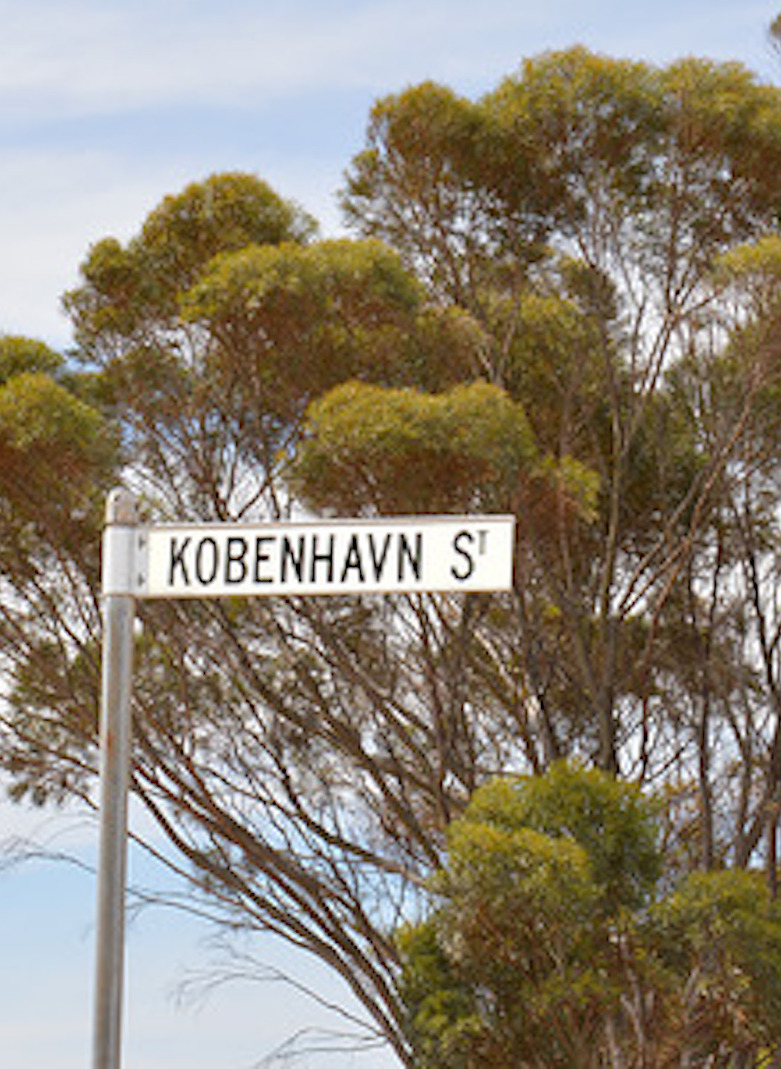
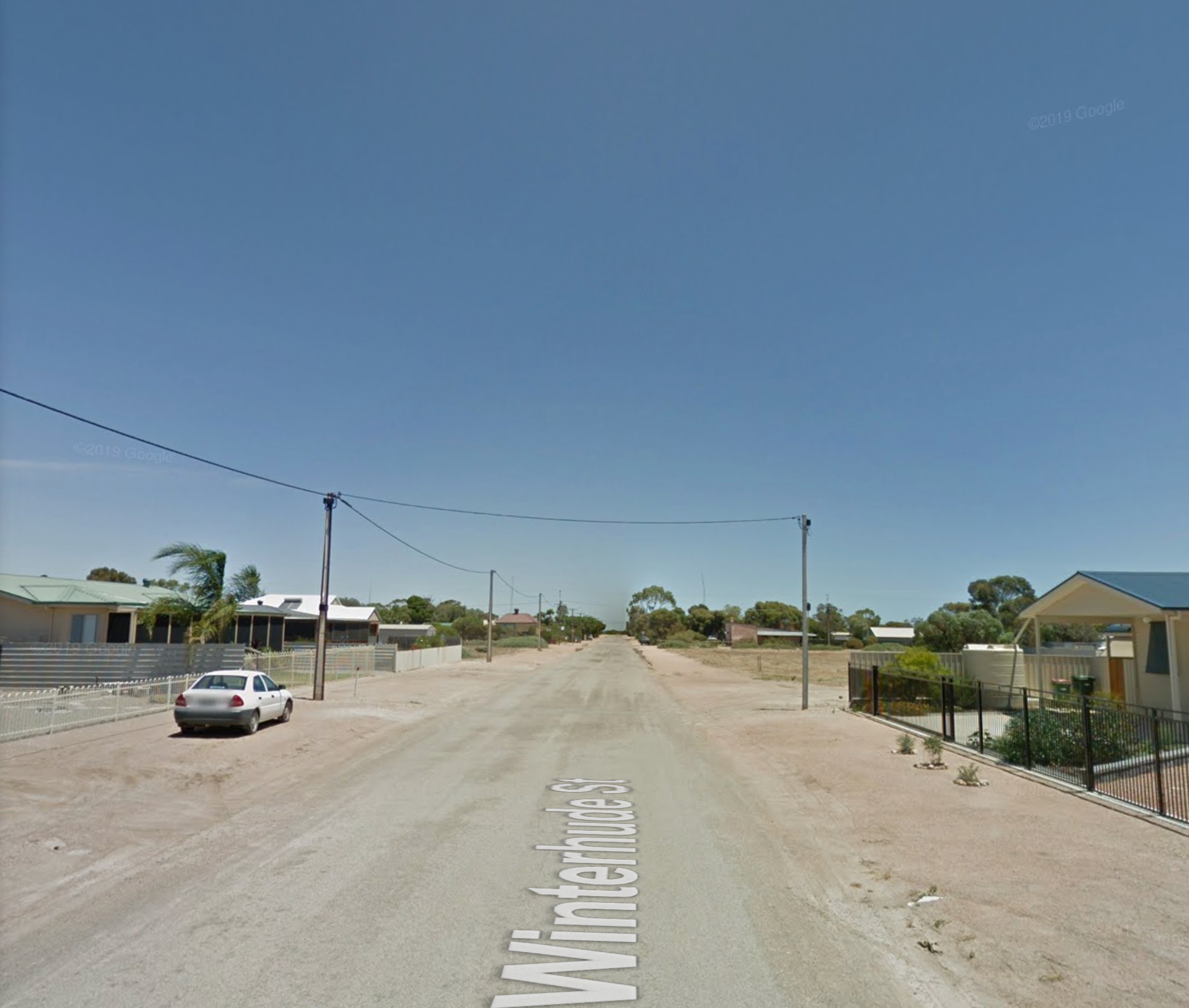




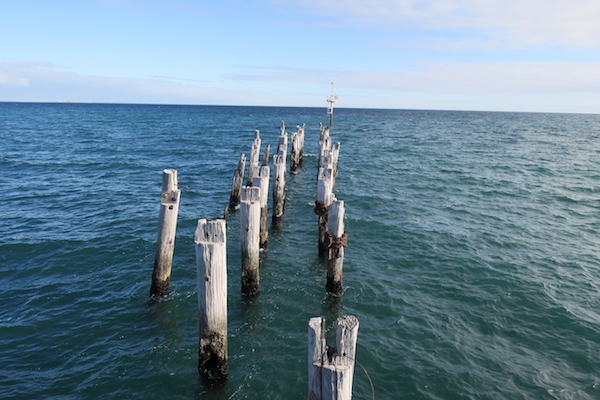

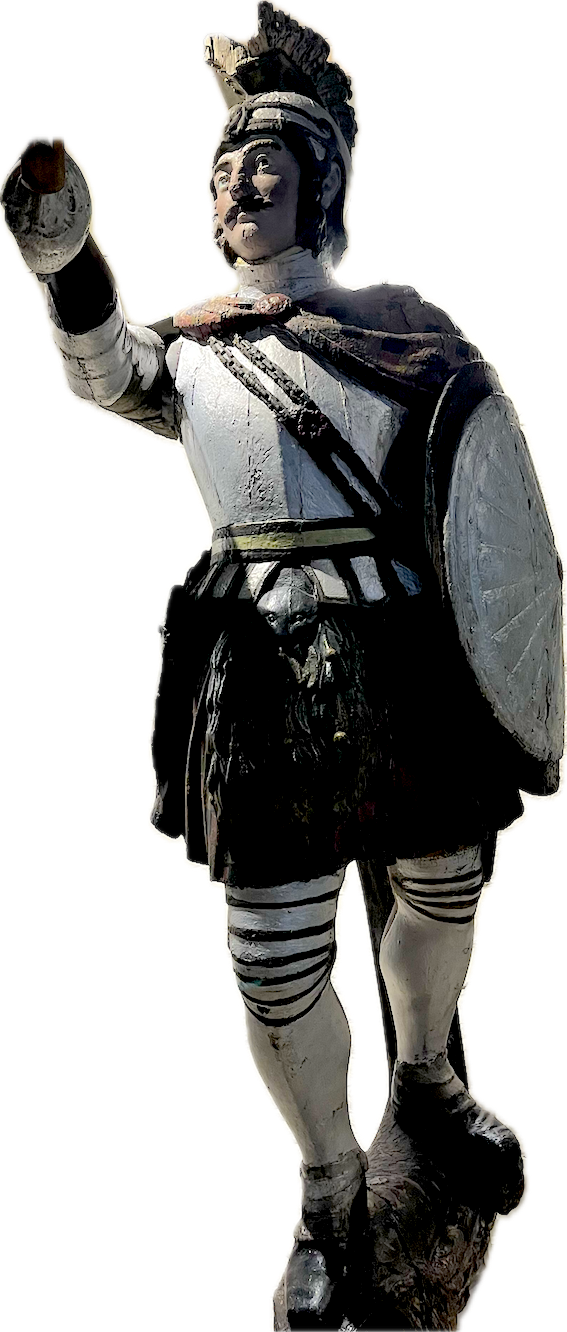
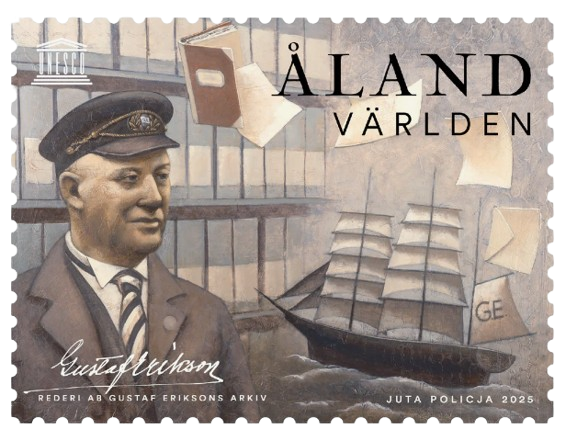 THE LAST SAILING SHIPS
Taken from one of the A. D. Edwardes photo albums of Shipping in SA in the State Library.
THE LAST SAILING SHIPS
Taken from one of the A. D. Edwardes photo albums of Shipping in SA in the State Library.
Photo at right: An Aland stamp released 25-8-2025: The Gustaf Erikson Shipping Company archives were included in UNESCO's
International Memory of the
World Register on 24 May 2023. At the time, Gustaf Erikson (1872 - 1947) was the dominating shipowner in Finland, known for his fleet
of windjammers. The Aland Maritime Museum and the Aland Provincial Archives are responsible for the material included in the archives.
LOADING SCANDINAVIAN SAILING SHIPS AT PORT GERMEIN
"Tall masts of the Erikson line of Scandinavian ships are silhouetted against the sky-line, their elegant
figureheads presenting an air of grace and dignity.
The 'Olivebank' is waiting at the jetty to take on a load of bagged wheat.
Captain Matsen is proud of his ship, and the crew will be kept busy during the two or three weeks in port while the cargo is being loaded.
Sails will be mended and all the general maintenance attended to-the whole ship will be made spick and span.
Down in High Street, the labourers have been wheeling bags up planks and onto rail trucks since around 7 am. Huge grain
stacks line the street around Farmers Union, Darlings and Drapers grain stores.
Arnold Miller understands the procedure very well-he has been a grain agent for many years, and now, in 1940, he has watched
the loading process a countless number of times.
Sixty five bags are loaded onto each of the seven trucks which will be pushed by the small engine, working in the rear, out to
the waiting ship. Twenty one trucks and two engines keep up a continuous haul. Empty trucks are pulled back with the engine in front.
First stop on the way out to the ship is at the coal bunker near the goods shed. The engine is fired up-then off out along the jetty.
The tide is out this morning so the ship is down. This means that the bags can chute straight down into the ship from the trucks.
When the tide is in and the ship is riding high, slings are placed around the bags and a winch on board the ship pulls them up to the chute.
When loading has been completed-about thirty to forty thousand bags, the 'Olivebank' will be ready to leave on the long journey home-
several months will be spent at sea.
If an east wind is blowing when the 'Olivebank' is ready to depart she will move off under
her own sail, otherwise a tug from Port Pirie will pull her out into the channel."
Taken from 'The Village Voice, Pt Germein & District,' June 1991, Edition 7, editor Lucy Abbott, as told by Arnold Miller.
(I have joined some of the shorter paragraphs to save space.)
L'AVENIR/ ADMIRAL KARPFANGER
This chilling story comes from TIME MAGAZINE, Monday, December 27, 1943
"The long swells of the South Atlantic break angrily against lonely Tristan da Cunha. In the volcanic rock of this island group,
halfway between Cape Town and Montevideo, they have scoured deep, dark caverns.
Far back in the recesses of one such cavern on Tristan Island, Arthur Repetto, brother of the island's headman, found a ship's
figurehead. Its ghostlike glimmer "skeered" him at first. When he went in he found a beautifully modeled maiden, nine feet high.
Her hair was done up in a bun behind her head; a long cloak, which her left hand grasped, covered her dress. Her right hand
held a lily to her bosom. Around her neck was carved a necklace of disks; a tasseled cord girdled her waist. On each arm was a
bracelet hung with draperies. The wood was well preserved, with few barnacles or seaweed, and traces of white, blue, green,
gold and red paint glowed faintly. Rusty iron bolts showed where the figure had been fastened to a ship's bow. With the help
of other islanders, Repetto brought the figurehead by boat to Tristan's settlement. There it was repainted, mounted at the
base of the flagstaff.
Four years after Repetto found the maiden, a ship touched at Tristan, took back photographs to Cape Town.
There a mechanic of the Royal Navy's Fleet Air Arm identified it as the figurehead of the 'Admiral Karpfanger,'
which had once been laid up in his Liverpool shipyard.
The 'Admiral Karpfanger,' a four-masted bark of 2,853 tons, put out from Port Germein, South Australia, on Feb. 8, 1938.
Aboard were 44 cadets and 16 officers and men of the Hamburg-America Line. Five weeks later she radioed her position from
somewhere south of New Zealand and said she would round Cape Horn. That was the last ever heard of her until the lily maiden was found."
Interestingly I found this exact story in the "Mail" (Adelaide, SA : 1912 - 1954), Saturday 25 March 1944, page 7, with no attribution to "Time" magazine or any othe source.
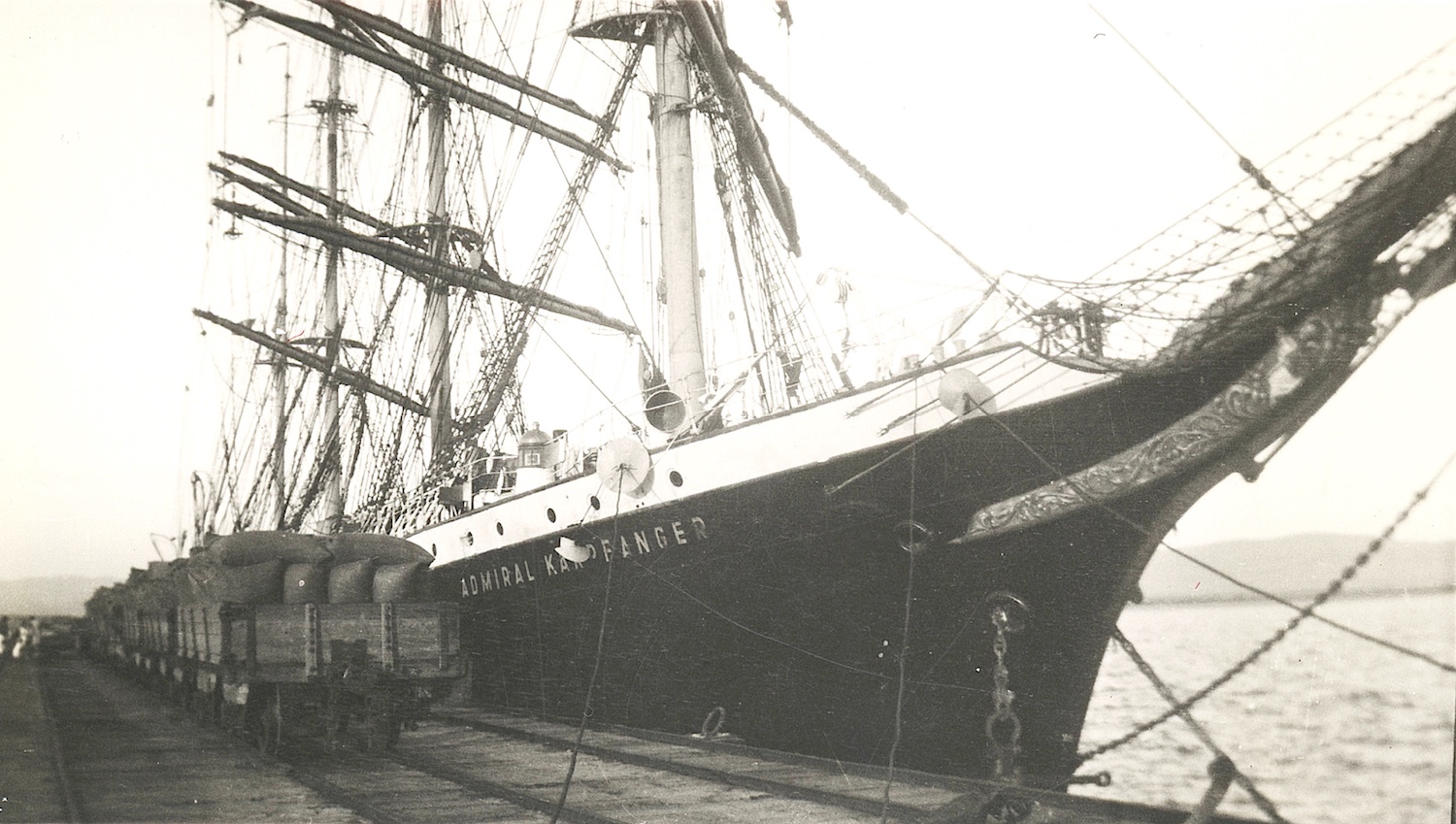
The 'Admiral Karpfanger' at Port Germein jetty in 1938, from State Library of South Australia Collection, [B 63693]
29 YEARS AS 'L'AVENIR'
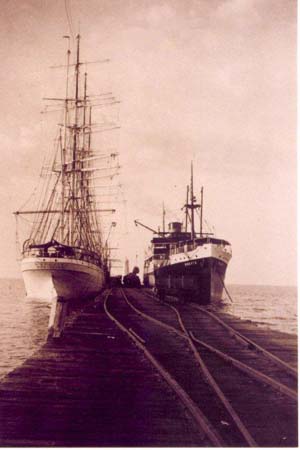 In fact, this was just the sad end of a ship
In fact, this was just the sad end of a ship 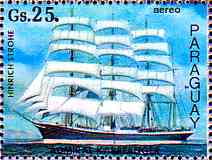 which had a fascinating history.
which had a fascinating history.
Built in 1908 by R. C. Rickmers in Geestemünde, (later Bremerhaven) Germany, for a Belgian company, Soc. Anon. Maritime de Belge S.A, and named
'L'Avenir',it was used as a sail training ship for Belgian merchant sailors for over 23 years.
In 1932 it was sold to Gustaf Erikson of Mariehamn, Finland, for the Australian wheat trade. It was a 4 masted steel barque, could take 60 passengers
and often made summer cruises in the Baltic.
"L'Avenir" apparently visited Port Germein in 1911 and a list of deserters in the Spencer Gulf ports, compiled by Frank Hall, 1987,
shows that 8 sailors left the ship there, three on 8-11-1911, one on the 10-11-1911, and two each on 11-11-1911 and 12-11-1911.
One famous passenger was Australian born composer Percy Grainger, best known for his song, 'Country Gardens'. He sailed to Australia on 'L'Avenir' with his second wife, Ella, on its 110 day voyage in 1933-1934. He took numerous photos and painted life aboard the ship, disembarking quickly at Port Germein from the long voyage. They had brought many musical instruments for the Grainger musical museum in Melbourne. Interestingly, although living in America for most of his life, and dying in New York on 28 February 1961, aged 78, Percy Grainger is buried in West Tce Cemetery, Adelaide, with the ashes of his mother, Rose Annie Grainger. His body was flown to Adelaide, and a funeral service was conducted on 2nd March, 1961, at Saint Matthew's Church, Marryatville, where his parents were married in 1880.
Picture at left (courtesy Robert Shaw) shows 'L'Avenir' at L and 'Moonta,' R, at the Port Germein jetty. The ship is also featured on the stamp at right
 L'AVENIR SAILORS HAVE SOME FUN AT PORT GERMEIN
L'AVENIR SAILORS HAVE SOME FUN AT PORT GERMEIN
Owen Broadbear, in his book, 'A Life's Memories,' tells a story about 'L'Avenir' being in port. (The French ship is actually 'L'Avenir')
"At one time two Swedish ships were taking in wheat, both at each side of the jetty, when a French ship pulled up at anchorage.
Of course, they had to get provisions, so either first or second mate would come to shore in a small boat with a few sailors.
Naturally they finished up at the hotel, where the Swedish sailors were drinking. The French and Swedes don't agree and it wasn't long
before the bar walls were getting splattered with blood. Local chap Constable Pearce couldn't quell the fight so got out of it and
ran home to ring the Pirie police. Anyway, before they got out, Pearce went back with cuffs in pocket and tried to handcuff the Swedes
as he had learnt from the barman or proprietor who were causing the most trouble. Away went the Swedes around the pub with Pearce after them,
about four times around. The Swedes caught up with Pearce, picked him up and took him to the clink. They took the keys out of his pocket
and put him in a cell and locked the door. Mrs Pearce then rang the Pirie police and another bloke came out with a duplicate key to let
Constable Pearce out of his own cell. By the time the first two police had arrived all sailors were up the jetty and on the ship and
by the time the police got to the boats, no talk, nobody did anything-what could two policemen do among forty or so sailors? The keys
were never found." (p 43)
UPPER CLASS WINDJAMMER LOVERS MARRY IN PORT GERMEIN
 Another story associated with the visit
of 'L'Avenir' to Pt Germein in 1934 is the marriage of passenger Miss Barbara Mary Strachey, 21, (born 17th July, 1912 died 15th October, 1999),
a rebellious English girl and Oxford graduate who acquired a liking for smoking cigars on the trip, to Mr Olav Arvidsson Hultin, 23, (born 1910, died 1979) a Finnish passenger
who had previously been to South Australia as a member of a sailing ship crew.
Newspaper articles said he was the son of the Professor of Classics at the University of Helsinki but recent information reveals that Mr Hultin senior was a librarian at the
University of Helsinki, a much published literary historian, and later a professor. The 'windjammer lovers' appear to have caught the imagination of newspapers around Australia and the event was widely
reported, even earning a two page article in the 'Australian Women's Weekly.' Unfortunately, Percy Grainger and his wife, fellow passengers on 'L'Avenir,' were unable to attend the wedding.
Another story associated with the visit
of 'L'Avenir' to Pt Germein in 1934 is the marriage of passenger Miss Barbara Mary Strachey, 21, (born 17th July, 1912 died 15th October, 1999),
a rebellious English girl and Oxford graduate who acquired a liking for smoking cigars on the trip, to Mr Olav Arvidsson Hultin, 23, (born 1910, died 1979) a Finnish passenger
who had previously been to South Australia as a member of a sailing ship crew.
Newspaper articles said he was the son of the Professor of Classics at the University of Helsinki but recent information reveals that Mr Hultin senior was a librarian at the
University of Helsinki, a much published literary historian, and later a professor. The 'windjammer lovers' appear to have caught the imagination of newspapers around Australia and the event was widely
reported, even earning a two page article in the 'Australian Women's Weekly.' Unfortunately, Percy Grainger and his wife, fellow passengers on 'L'Avenir,' were unable to attend the wedding.
On January 16th, Barbara and Olav were married at the tiny St Clemens Church of England next to the school in Port Germein. It was 104 degrees, the people of Port Germein turned out in droves and the church was beautifully decorated with flowers. The bride dressed at the Port Germein Hotel in an old gold crepe ensemble decorated in brown while the groom wore his white dress sailing suit. A Fox Movietone News reel cameraman, Mr W. Simmons of Adelaide, was apparently in attendance. After the wedding, the party drove to the Royal Exchange Hotel in Port Pirie for the reception.
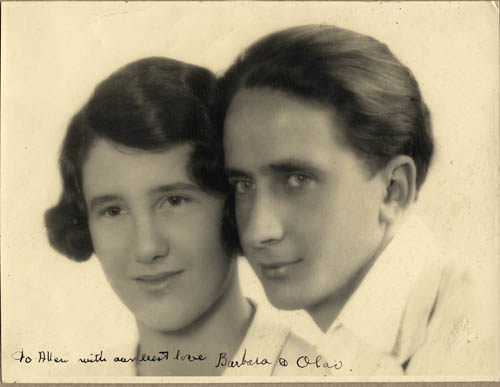 The two pictures of the couple were sent by Allen Payze, the then secretary of the Port Lincoln Yachting Club,
to the Åland Maritime Museum at Mariehamn, Finland and digital copies from there to me (with thanks).
Allen Payze is shown on the top deck with the couple on the coastal steamer 'Moonta' (see 'Gulf Trip' below) which took them from Pt Lincoln to Port Pirie before the wedding.
Allen Payze gave the bride away on the day. Payze had met Olav Hultin when he came to Australia 2 years previously aboard the 'Ponape.'
The two pictures of the couple were sent by Allen Payze, the then secretary of the Port Lincoln Yachting Club,
to the Åland Maritime Museum at Mariehamn, Finland and digital copies from there to me (with thanks).
Allen Payze is shown on the top deck with the couple on the coastal steamer 'Moonta' (see 'Gulf Trip' below) which took them from Pt Lincoln to Port Pirie before the wedding.
Allen Payze gave the bride away on the day. Payze had met Olav Hultin when he came to Australia 2 years previously aboard the 'Ponape.'
Some details of the romance are contained in the newspaper articles. The couple were divorced only 3 years later so the mother's warning seems to have been well founded. They had one son, Roger.
Barbara Strachey was the niece of the
writer, Lytton Strachey, and mixed with many other well known literary figures of her day including Virginia Woolf and Bertrand Russell.
She wrote an atlas to Tolkien's 'Lord of the Rings' called "The Journeys of Frodo"
and worked in BBC radio for many years.
A FEMALE SAILOR ABOARD L'AVENIR
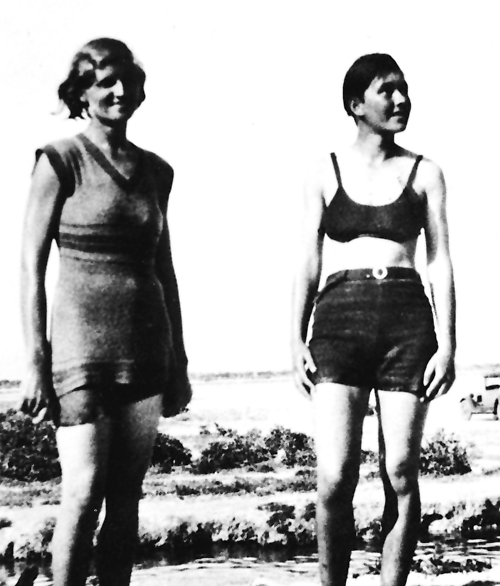 On 'L'Avenir' also was a Canadian female cadet, Annette Brock (commonly known as Jacky), who wrote her story in
My Year Before the Mast. When one of the other passengers, Miss Kronig, had to be rushed to Port Pirie Hospital because of an injury to her leg, Annette Brock took her place as bridesmaid at
the wedding. She wore a wide sleeved tangerine top with brass buttons, a black skirt and black beret.
On 'L'Avenir' also was a Canadian female cadet, Annette Brock (commonly known as Jacky), who wrote her story in
My Year Before the Mast. When one of the other passengers, Miss Kronig, had to be rushed to Port Pirie Hospital because of an injury to her leg, Annette Brock took her place as bridesmaid at
the wedding. She wore a wide sleeved tangerine top with brass buttons, a black skirt and black beret.
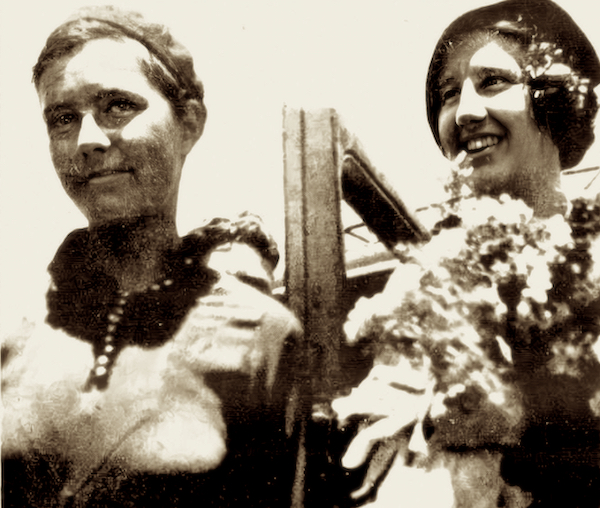 In her book she has a whole chapter about Port Germein including a story about an evening spent at the beachfront Palais de Danse (later known simply as The Palais),
which she describes as:
In her book she has a whole chapter about Port Germein including a story about an evening spent at the beachfront Palais de Danse (later known simply as The Palais),
which she describes as:
"...a big bleak shack painted in peeling white. It was round, with large letters encircling it, announcing with all the comic
dignity of a kookaburra bird, that it was the Palais de Danse. As we approached, a pianola
could be heard through the ramshackle boards, reeling out
'Ten More Months and Eleven More Days.' (Actually the song is '11 More Months and 10 More Days' ed) How absurd, I thought in this vast panorama of sea and desert."
If you click on the pianola link you will hear Percy Grainger playing 'Country Gardens'
in 1919 (When my own Autotone Pianola was made).
Above L :Jacky on Port Germein beach (in 2 piece bathers); Jacky (Annete Brock) and Barbara Strachey dressed for the wedding, 'The Chronicle,' Feb 1st, 1934.
L'AVENIR RETURNS AS ADMIRAL KARPFANGER
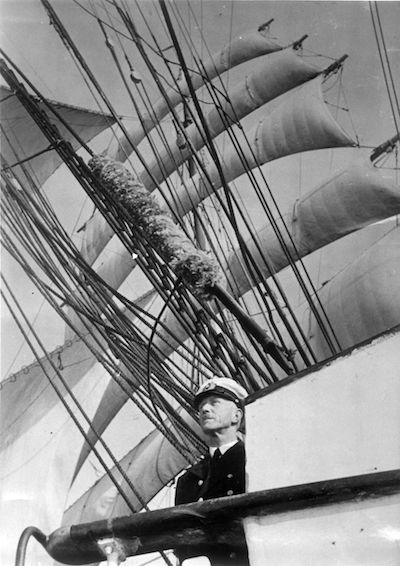 In 1937 'L'Avenir' was sold to Norddeutscher Lloyd as a training ship, refitted and renamed 'Admiral Karpfanger'.
The ship under Captain Reinhold Walker was moored alongside the Port Germein jetty on January 6th, 1938, and loaded with 3,447 tons of wheat over a month.
During that time the cadet sailors attended a dance aboard the ship 'Moonta' which was visiting the port. Passengers were much impressed with the good
manners and singing skills of the crew. They also visited farms nearby.
In 1937 'L'Avenir' was sold to Norddeutscher Lloyd as a training ship, refitted and renamed 'Admiral Karpfanger'.
The ship under Captain Reinhold Walker was moored alongside the Port Germein jetty on January 6th, 1938, and loaded with 3,447 tons of wheat over a month.
During that time the cadet sailors attended a dance aboard the ship 'Moonta' which was visiting the port. Passengers were much impressed with the good
manners and singing skills of the crew. They also visited farms nearby.
The following information comes from the
Maritime Quest
web page:
"The 'Admiral Karpfanger' sailed from Port Germein, South Australia, on Feb. 8, 1938 with 33 cadets, 23 crew and 3,500 tons of
wheat bound for Hamburg. Her radio generator was known to be malfunctioning but radio contact was
maintained until March 12, when the last message was received. They reported "all is well" but after this message
she was not heard from again.
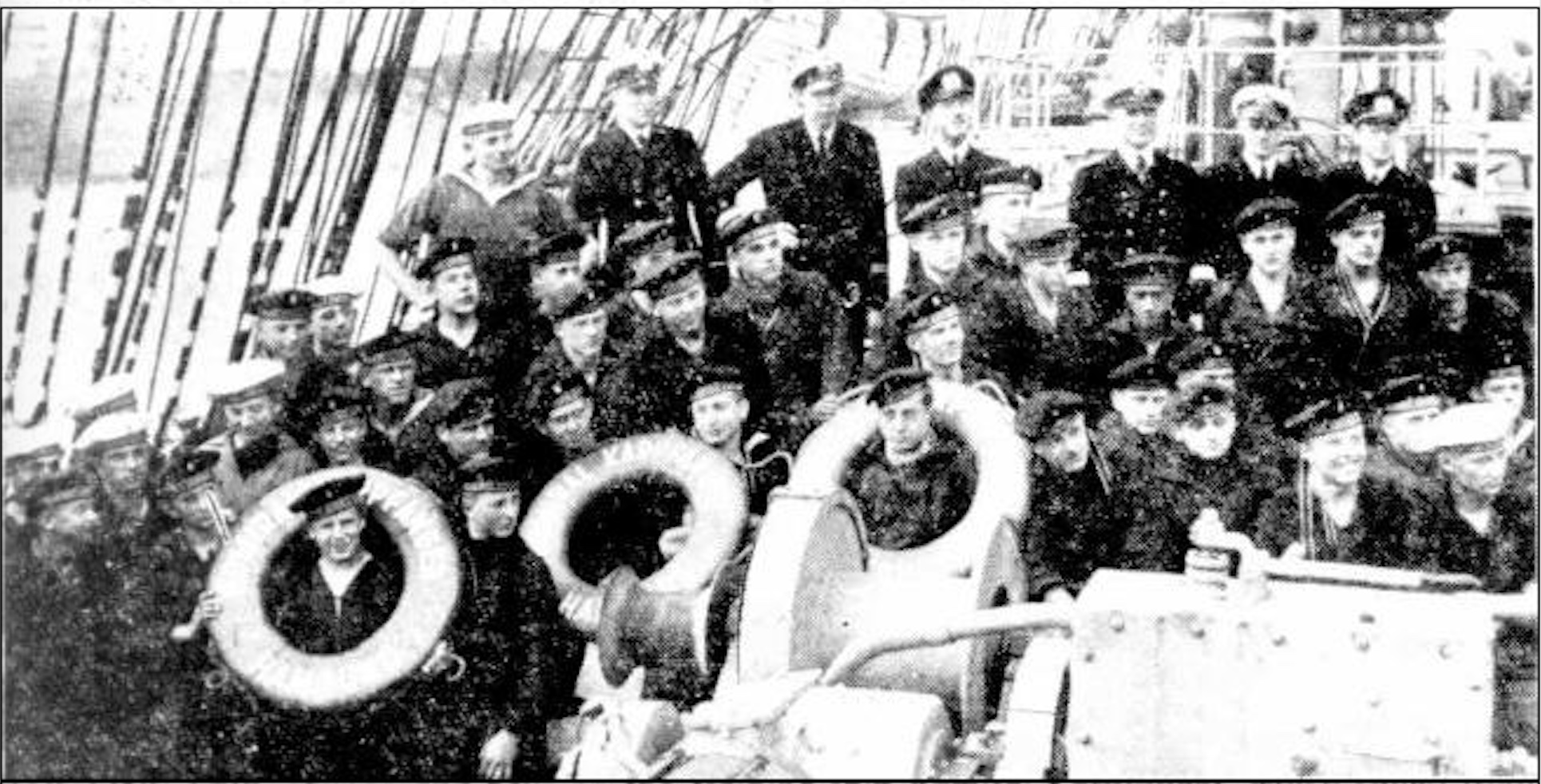 At right: Crew of 'Admiral Karpfanger,' probably taken at Port Germein, from 'The Advertiser,' 10 August, 1938.
At left: Captain Reinhold Walker below billowing ship sails.
At right: Crew of 'Admiral Karpfanger,' probably taken at Port Germein, from 'The Advertiser,' 10 August, 1938.
At left: Captain Reinhold Walker below billowing ship sails.
THE PENANG
Another tragic story associated with shipping at Port Germein was that of some crew of 'The Penang,' as told by Noel Smith.
On the 2nd February, 1937, the Barque 'Penang' lay at anchor approximately one ship's length from the Port Germein jetty. The crew had been invited ashore
to what Captain K.V. Karlsson described as some kind of festivities. They had been given permission to use the ship's rowing boat.
The captain discovered that eleven men had gone ashore in that boat, too many for a boat of that size. He instructed the first mate
to go ashore in the motor boat with specific, strict orders to see to it that when returning to the ship, the crew should be divided
into two loads. Those are the captain's words taken from his report. He would have known too that the sea breeze which usually comes
into Port Germein in mid to late afternoon could become quite strong during the night and that a nasty short, steep sea would get up when it did.
Sadly, the revellers, returning from the party full of good cheer and indiscretion either forgot or chose to ignore their captain's proper
and very wise instructions. The sea had become quite rough but their ship was only a short distance away. They were young; they were strong;
they were of races bred to the sea. They too, were very foolish. Twelve men boarded that small boat. It capsized just beneath the ship's stern.
Carpenter Harry Axel Lindquist, born 17 July, 1915, of Lenland, Finland, and apprentice Lars Rasmussen, born 27 February, 1915, of Bjerby, Borup, Denmark, were lost.
One other was picked up unconscious and very nearly lost his life.
After the funerals at Port Germein, Mrs Huchison had two wooden crosses placed on the graves of the young sailors.
These were eventually destroyed by weather and termites but in 1986 it was decided that as part of the Jubilee Commemorations the graves
would be put in good order and plaques placed upon them. The project was the joint effort of the people of Port Germein and the town council.
A half brother of Harry Lindquist visited the graves in 1986. Captain Gote Sundberg from Mariehamn visited them in 1988.
'Penang' sailed from Port Lincoln and was torpedoed off the coast of Ireland on December 8th, 1940.
There were no survivors. So many lives lost and so many beautiful ships destroyed.
OTHER BIG SHIPS VISITING PT GERMEIN DURING THE GRAIN RACES
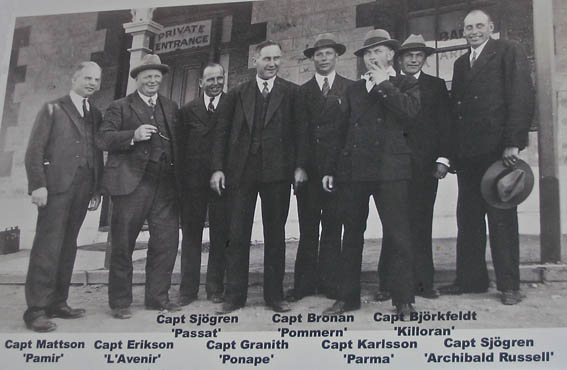 On left: Ship captains pictured at Pt Victoria in 1934
On left: Ship captains pictured at Pt Victoria in 1934
Below: From an article in the 'Falmouth Packet' called 'Bygone Days Revisited'
"In the Australian grain loading ports of Port Victoria, Port Germein and Port Lincoln, situated in Spencer's Gulf, 13 sailing ships loaded their grain cargoes for Europe in what was to be the last Grain Race of any magnitude. The average passage time from Australia to Europe for the 1939 race was 124 days. Of the 13 ships that left Southern Australia five were bound for Falmouth for orders, three for the Lizard to pick up instructions and the remainder sailed for Queenstown, Ireland. Freight rates saw grain being carried for 25 shillings per ton. Ships normally sailed from Australia in March and April for the 100-plus days passage to Europe either via Cape Horn or the Cape of Good Hope. Between 1921 and 1939 a total of 328 sailings were made from the Australian Grain ports."
SAILING SHIP VISITS TO PORT GERMEIN DURING THE GRAIN RACES
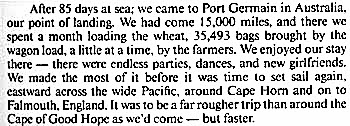 FAVELL
FAVELL
Arrived 20-11-1926, sailed 21-01-1927
Arrived 21-12-1932, sailed 26-01-1933
Arrived 27-03-1934, sailed 16-04-1934
This 3 masted ship made her last voyage on the wheat trade and was scrapped in 1934
C B PEDERSEN
Arrived 13-02-1933, sailed 06-03-1933
Arrived 05-02-1936, sailed 25-03-1936
Arrived 29-12-1936, sailed 21-01-1937
A four masted barque, 'C B Pederson' sank when rammed by the Elders & Fyffes steamer 'Chagres' of Glasgow, SW of the Azores at position 35 degrees 36 N and 35 degrees 41 W on April 25th, 1937, on her way home from Pt Germein. The master of the 'Chagres' died of a heart attack at the accident but all crew were saved.
OLIVEBANK
Arrived 09-03-1932, sailed 13-04-1932
English/Finnish four masted barque
Struck a mine and sank in 1939, 7 crew surviving
POMMERN
Arrived 11-01-1932, sailed 21-02-1932
Arrived 01-09-1932, sailed 21-09-1932
Arrived 28-01-1935, sailed 04-03-1935
Arrived 08-03-1938, sailed 26-03-1938
Arrived 11-02-1939, sailed 01-03-1939
In 1932 the 'Pommern' was apparently the fastest boat on the Europe to Australia leg. She was laid up in Mariehamn in 1939 and is now on full display having over 50.000 visitors a year (from Ships Nostalgia)
WINTERHUDE
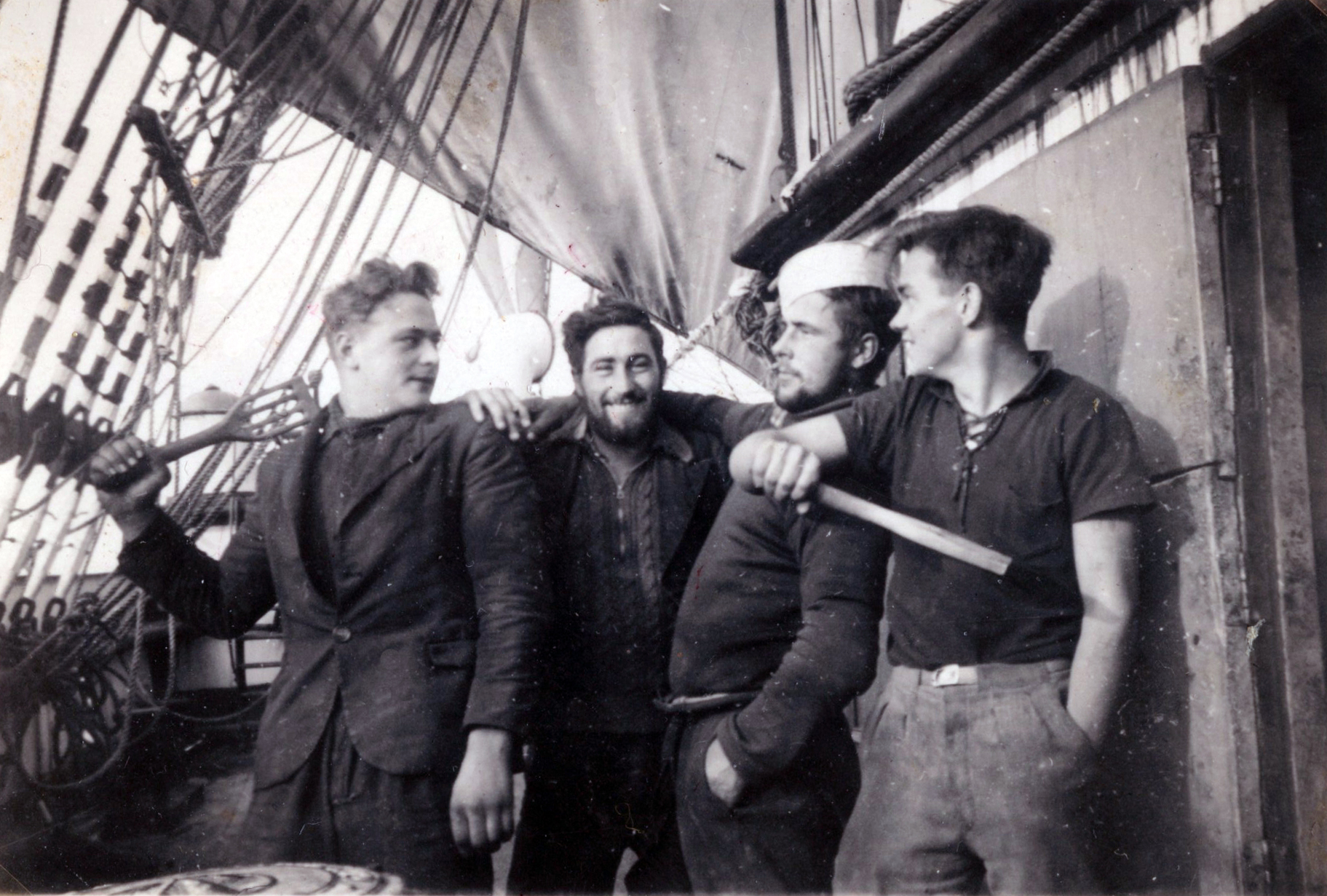
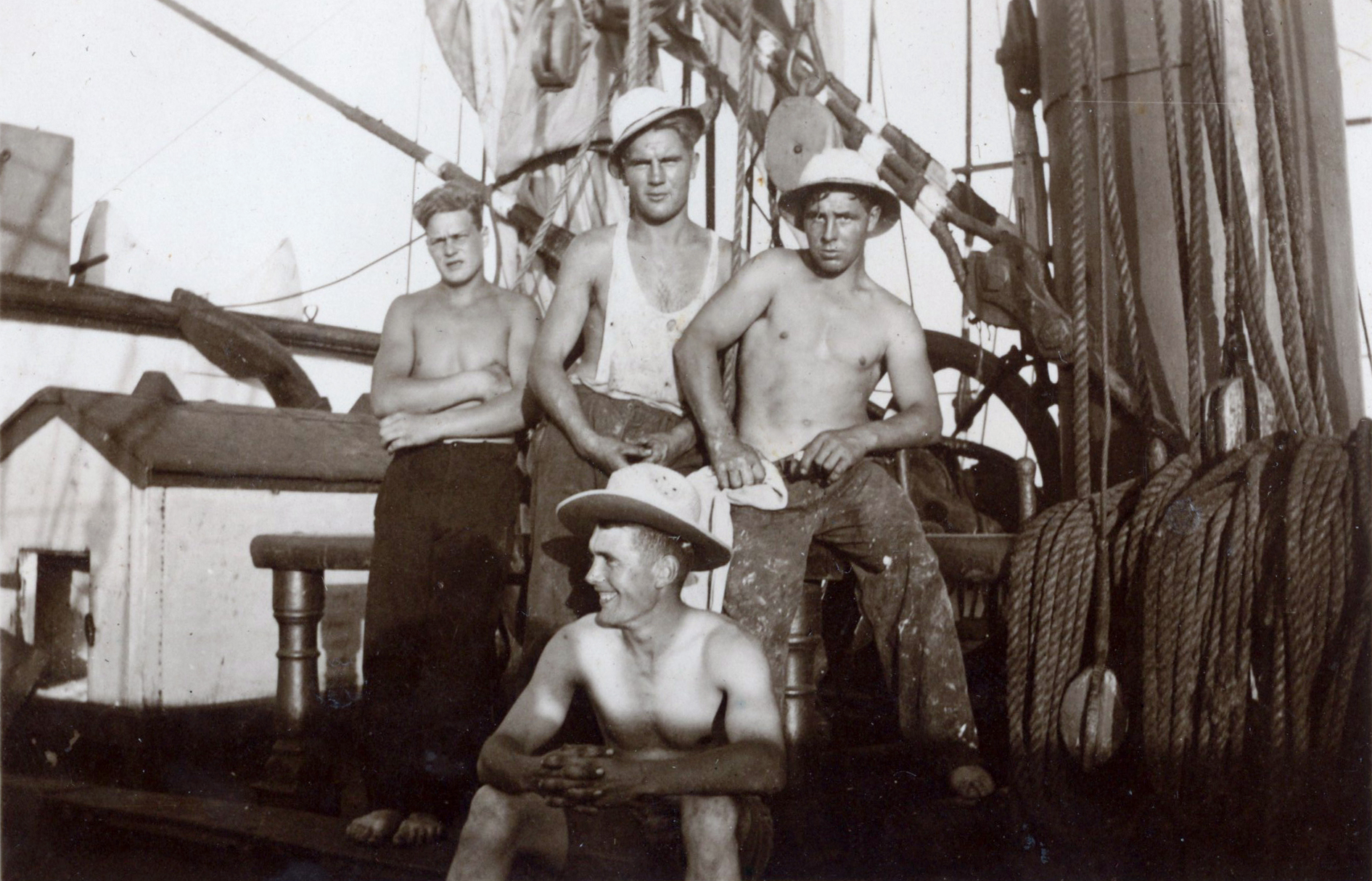
Erik Eliel Isaksson was born in Turku Archipelago, in Pargas, a Swedish speaking region of Finland. He joined the Winterhude in Mariehamn when he was 17 years old, and was a member of the crew when the ship visited Port Germein to load wheat in 1939. He is pictured on the far left in both photos. ( Photos kindly supplied by his son, Juhani Isaksson)
Arrived 26-01-1934, sailed 22-02-1934Arrived 30-01-1936, sailed 06-03-1936
Arrived 10-04-1937, sailed 28-04-1937
Arrived 12-01-1938, sailed 05-03-1938
Arrived 14-02-1939, sailed 17-03-1939
A 3 masted steel ship built in 1898, in Bremen, Germany as 'Mabel Rickmers;' sold 1912, rerigged as barque and re-named 'Winterhude;' sold and for a year renamed 'Selma Helmsoth' ; sold 1925 to Gustav Erikson, Mariehamn, Aland and renamed 'Winterhude;' survived until being broken up in 1949
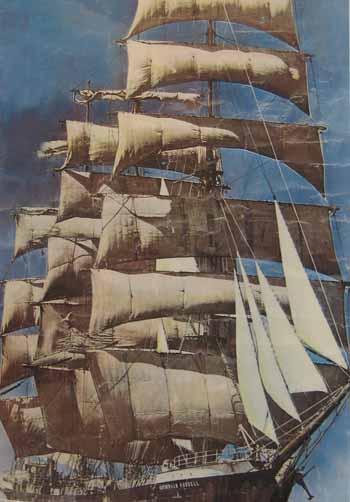 L'AVENIR
L'AVENIR
Arrived 12-01-1934, sailed 07-02-1934
4 masted steel barque built in Geestemunde, Germany in 1908 and bought as a sail training ship. Sold to Gustav Erikson in 1932, then to Hamburg Amerika Line in 1937 as a sail training ship and renamed 'Admiral Karpfanger'-see above. The ship was lost without trace in 1938.
ARCHIBALD RUSSELL
Arrived 11-02-1935, sailed 21-03-1935
Arrived 17-02-1937, sailed 02-03-1937
Arrived 29-04-1938, sailed 10-05-1938
Arrived 05-03-1939, sailed 01-04-1939
4 masted steel barque, pictured at right, sold to a British company and broken up, 1949
MOZART
Arrived 30-01-1934, sailed 13-03-1934
4 masted steel vessel built 1903 Greenock, England, for German company; sold to L. Lundqvist of Mariehamn, Finland in 1922, scrapped in September, 1935 at Dalmuir
Arrival and sailing information obtained from a list compiled at Pt Germein Village Museum.
FRENCH SAILING SHIPS AT PORT GERMEIN
In his book 'French Sailing Ships at Australian Ports, Arrivals and Departures 1898-1925' published 2010, Patrick Ahern
has compiled lists of the French ships which visited Australian ports and has kindly allowed me to reproduce the Port Germein list (19-1-2015).
He explained that there may have been additional arrivals between Jan 1917 and Aug 1918 which were unpublished because of wartime restrictions.
The ships all carried wheat and sailed for Falmouth or other European ports.
Pierre Antonine Feb 1904 to 01-03-1904
Maréchal Davout Jan 1906 to 16-02-1906
Molière Feb 1906 to 19-3-1906
Maréchal de Noailles 01-03-1906 to 09-04-1906
Amiral Corbet Nov 1906 to 07-01-1907
Maréchal de Noailles Jan 1907 to 16-2-1907
Empereur Ménélick Dec 1907 to 6-2-1908
Molière Dec 1908 to 14-2-1909
Marguerite Dollfus Jan 1909 to 06-03-1909
Edmond Rostand Jun 1913 to 25-06-1913
St Louis to 25-1-1921
Versailles Feb 1921 to 5-4-1921
Thiers Apr 1921 to 7-5-1921
PORT GERMEIN SHIPPING REGISTER
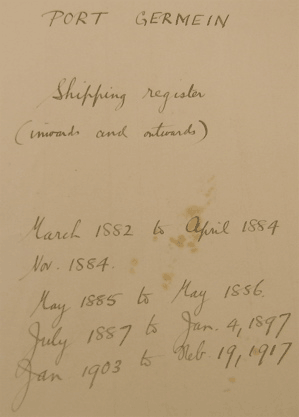
The Port Germein shipping register for 1882-1884, 1903 and 1914-1916 is a
solid book containing a hand written record of ships coming and going
at Port Germein for just a small part of its shipping history. Only a few pages of the whole book have been used.
Most of the records from the Harbour Master's Office at the start of the jetty were seen being deliberately burnt in a bonfire
on the beach by an official from the Harbours Board when the town was declared to be no longer a port. Who knows why? Perhaps it was
just easier to burn history than to work out what to do with it.
Some of the register entries are thorough and others involve a series of ditto or iteration marks. When this occurs I have written the words in. Though neat, the cursive was often difficult to read but I have looked up the names of many ships in the Shipping News of old newspapers. There are probably still many mistakes so please email corrections. It has been a long process typing up all this information but interesting. Now I would like to get a picture and details of ships in the list, and the captains also seem worthy of note! Words like ketch, steamer, barque, cutter are exerting their siren songs too.
SAILING SHIP STREET NAMES AT PORT GERMEIN FROM 2012
Twelve street names in Port Germein were changed from ordinal numbers to the names of famous ships of the wheat trade (below), in October 2012.
Note that the ship name was 'Admiral Karpfanger.' It was not spelt with 'ae.' Of course we were keen to pose with Danish relatives under the
København street sign in the main street, next to the pub on a visit to Port Germein in 2023. Sadly the council has chosen
to add a sign to the rubbish dump in this choice location!
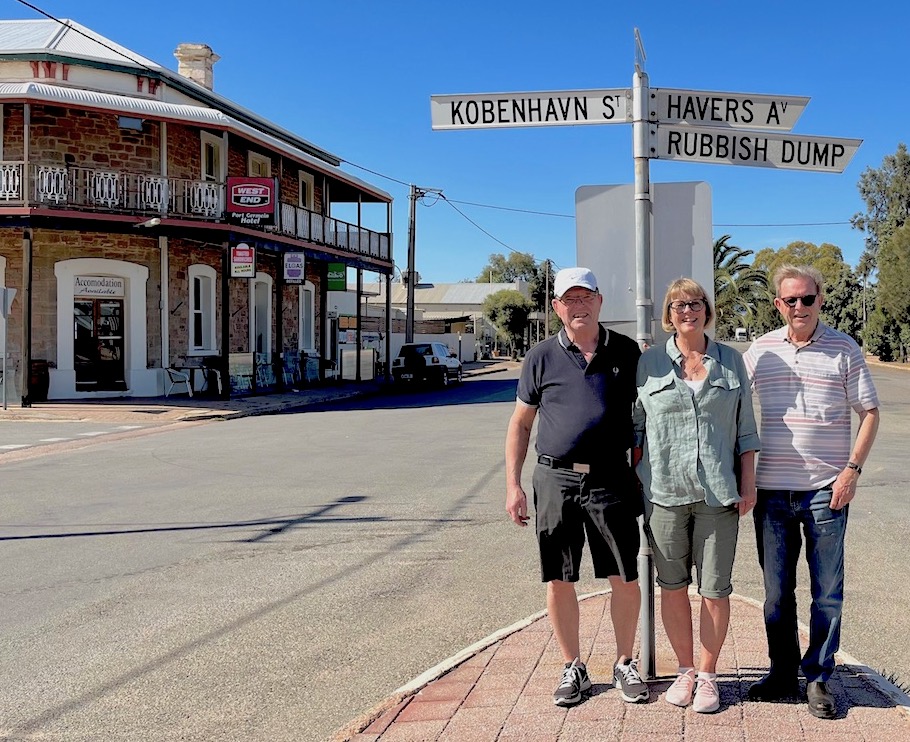
Photo: Eilif, Hanne, Peter and I would like an ø in København and no dump sign.
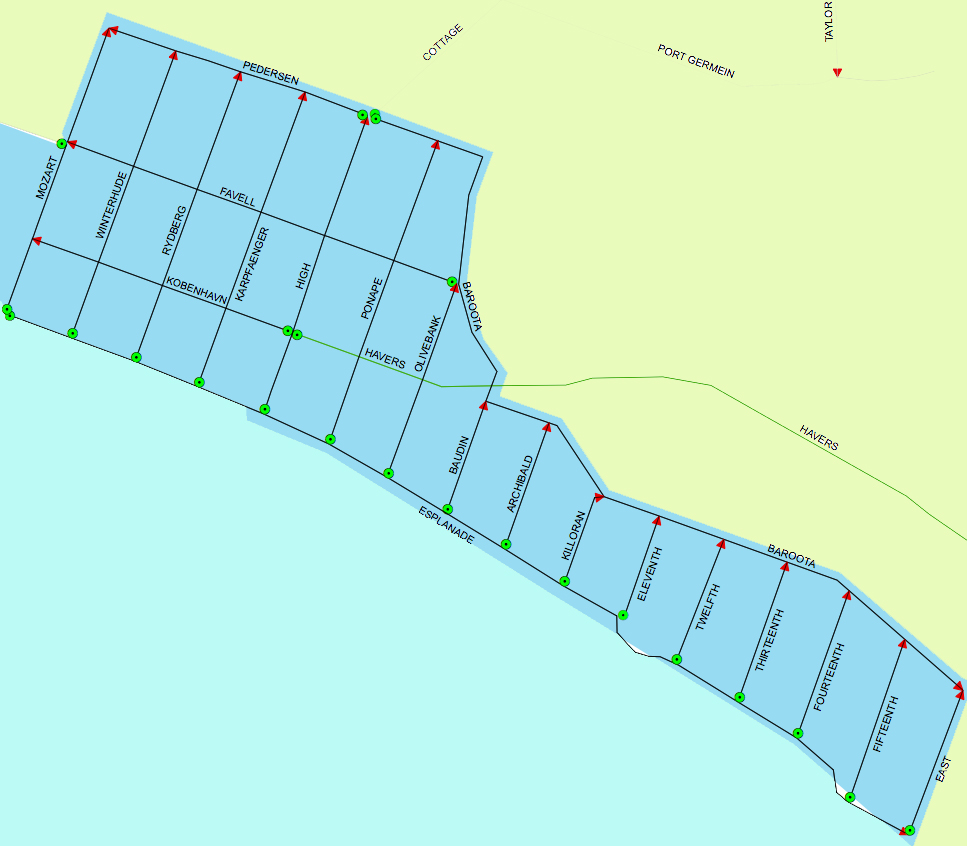
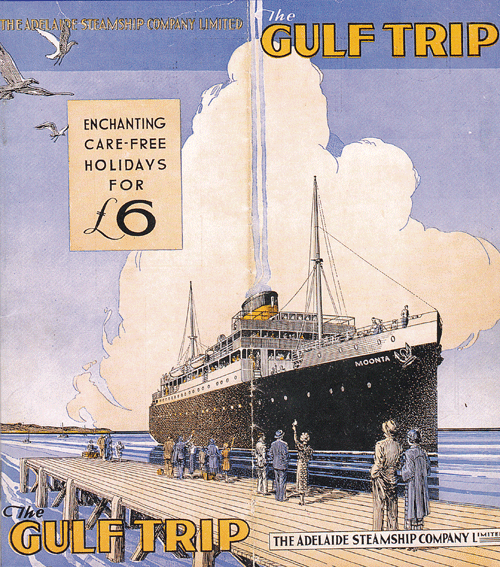 THE GULF TRIP
THE GULF TRIP
Though sailing ships were not used for the Gulf Trip, they were often in port loading wheat when the Paringa or Moonta arrived.
At left is the cover of
The Gulf Trip edited by Dieuwke Jessop, from the S.A Maritime Museum,
about 6 day cruises with all the glamour of ocean travel, run by the Adelaide Steamship Company from 1906-1955. Port Germein was one of the stops along
the way. It was a most convenient and pleasant method of travel around the state to areas not easily accessed by road transport.
One of the best known ships on the Gulf trip was the Moonta built in Copenhagen by Burmeister and Wain in 1931 to replace the Paringa
and arriving in Australia in November 1931. It was a one class ship of 2,693 tons, 3000 tons gross, and traded between Ports Adelaide, Lincoln, Germein,
Pirie, Augusta, and Hughes until 1955. There was accommodation for 140 passengers. The ship departed Port Adelaide on Saturday afternoons. It was driven by
diesel engines and had four decks including a special deck for sports and dancing. She was equipped with modern wireless equipment made by
Amalgamated Wireless in Australia, allowing gramophone music to be relayed all over the ship. (Information from newspaper articles via TROVE)
Many couples spent their honeymoon on the Moonta and singles looking to meet members of the opposite sex,
not always with a view to marriage, enjoyed the ship too, I'm told.
SHIPS AND JETTY
This is an old page I created using photoshop about 11 years ago, so I hope it works. Click on the ship name and keep scrolling down to find them all.
Photos of ships
SHIP LINKS
Vessel Tracker shows ships in ports around the world but the
tracker named Port Pirie is actually located in Port Germein as of November, 2019.
Gustaf Erikson
Photos on Flickr of last Grain race in SA.
Maritime Museum of SA, research.
Page created 10-7-2009 by L. Nordestgaard. Added shipping register 11-4-2011, French ships 19-01-2015, Pt Germein ship deserters 1-4-2015,
ship deserter lists moved to new page, 20-5-2020. Material added and re-organised, 2-12-2019. Photos added 22-2-21. Links checked 15-4-2025.
Photos at left:Noel Smith as a cabin boy; sculpture of sailing ship by Noel Smith; under the jetty; town from jetty end; fishing from the jetty: lighthouse; memorial plaque; our dog, Tammy, on beach, 1960; sign at Telowie; new street signs; Winterhude Street leading to the sea; goods shed; the old harbour masters' mast, relocated to the goods shed; public art; sea and Flinders Ranges; jetty end; the original fireplace in what was the ladies' lounge at the Pt Germein Hotel when my parents were mine hosts; ship figurehead from Port Adelaide Maritime Museum.